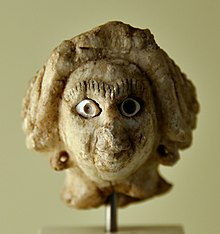Early Assyrian period
The archaeological evidence suggests that Assur was originally inhabited by Hurrians[3][4] and was the site of a fertility cult devoted to the goddess Ishtar.
At some point before the rise of the Akkadian Empire, the Semitic-speaking ancestors of the later Assyrians settled in Assur and the surrounding area, either displacing or assimilating the original population.
Throughout the centuries prior to Puzur-Ashur I, it is instead evident that the city was dominated by a sequence of powerful states and empires from southern Mesopotamia.
In the 24th to 22nd centuries BC, the city was part of the Akkadian Empire as an administrative outpost in northern Mesopotamia, a time later Assyrian kings saw as a golden age.
[15] Much of the early historical remains of Assur may have been destroyed during the extensive construction projects of later Assyrian kings, who worked to create level foundations for the buildings they erected in the city.
[19] Later Assyrian kings used the name "Baltil" or "Baltila" to refer to the earliest portion of Assur, or perhaps to a preceding settlement in the same location.
Subir, which also appears in the variants Subar and Subartu, is attested as a name for the land surrounding Assur, but the later Assyrians rarely used it.
[22] One inscription dedicated to Manishtushu was inscribed on the bronze point of a spear by Azazu, a local ruler of Assur who was the Akkadian king's vassal.
According to the later Babylonian text Legend of Naram-Sin, a strange-looking army of the Lullubi invaded the northern parts of the Akkadian Empire before continuing southwards and eventually reaching Babylon itself.
The Akkadian Empire collapsed in the early 22nd century BC, probably due to rebellions in southern Mesopotamia and the invasions from the eastern Gutians.
The rulers of Ur were not as concerned about northern Mesopotamia as the Akkadians had been, but they did conduct campaigns and conquests in the region and established control over Assur.
[3] Given that the earliest rulers are described as "kings who lived in tents", they, if real, may not have ruled Assur at all but rather have been nomadic tribal chieftains somewhere in its vicinity.
[8] This nomadic origin fits poorly with the archaeological record from Assur and neighboring sites, which instead indicates intense agriculture and early urbanization.
[13] Among the scant archaeological evidence recovered of early Assur are the remains of two temples built in mudbrick, both dedicated to the goddess Ishtar.
[46] Also recovered in conjunction with these temples were 87 alabaster figures of worshippers, ranging in height from 20 to 65 centimeters (8 to 26 inches), depicting both men and women.
Also found among the artefacts of Ishtar G are a clay bottle with the features of a nude woman as well as a figurine of a man with an erect penis.
[48] In addition to the figures and the architecture, other archaeological finds, including pottery and a vase, from early Assur also demonstrate strong Sumerian influence.
Found in one of the temples was also a fragment of a bedstead which depicts a woman lying down, wearing a choker, earrings and several rings with exposed breasts; the typical style associated with a deceased Sumerian noblewoman who was to be buried.
[5] It is impossible to confidently determine the ethnic composition of Assur's early population based only on material evidence[49] but it is unlikely to have been homogenous.
[4] As suggested by the historical evidence concerning Baltil and Subartu, the site of Assur and the surrounding lands were probably originally inhabited by Hurrians,[3][4] who were either assimilated[3] or displaced[4] at some point when the Semitic-speaking ancestors of the later Assyrians settled the region.
[4] According to the Assyriologist Georges Roux, many of the early names in the Assyrian King List, such as Tudiya, Ushpia, Sulili and Kikkia, are not Semitic or Akkadian in origin, but could perhaps be Hurrian.
[38] Though they are commonly distinguished by modern historians through calling the god Ashur and the city Assur, both were inscribed in the exact same way in ancient times (Aššur).
[55] Assyrians of later periods linked Ashur to Ishtar and though it was never expressly stated, they were sometimes mentioned together in inscriptions as if they were husband and wife.




